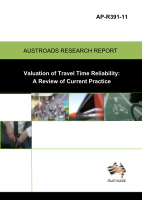Economics and Financing

Valuation of Travel Time Reliability: A Review of Current Practice
- Publication no: AP-R391-11
- ISBN: 978-1-921709-96-8
- Published: 23 September 2011
- PDF (free) Download
This report introduces key methodologies and the associated challenges with regards to defining and measuring travel time reliability, in particular, for improving the valuation of travel time in project appraisal by Australian jurisdictions.
This is in line with the main objective of the project to conduct a review of the international practice on key methodologies on the valuation of travel time reliability for road transport project evaluation.
- 1. INTRODUCTION
- 1.1. Scope of Project
- 1.2. Structure of the Report
- 2. TRAVEL TIME RELIABILITY: DEFINITION AND TERMINOLOGY
- 2.1. Definition 1: Reaching Destination in Acceptable Time
- 2.2. Definition 2: Travelling with Non-recurring Congestion
- 2.3. Definition 3: Consistency and Dependability in Travel Times
- 2.4. Definition 4: Reliability and Variability
- 2.4.1. Reliability Defined
- 2.4.2. Variability Defined
- 2.5. Definition 5: Transport System Ability and Performance
- 2.6. Reliability Definitions, Measures and Models
- 3. MEASUREMENT OF TRAVEL TIME RELIABILITY
- 3.1. Statistical Range Measures
- 3.1.1. Travel Time Window
- 3.1.2. Percent Variation or Coefficient of Variation
- 3.1.3. Variability Index
- 3.1.4. Displaying Variation
- 3.2. Buffer Time Measures
- 3.2.1. Buffer Time
- 3.2.2. Buffer Time Index
- 3.2.3. Planning Time Index
- 3.2.4. Travel Time Index
- 3.3. Tardy Trip Indicators
- 3.3.1. Florida Reliability Method
- 3.3.2. On-time Arrival
- 3.3.3. Misery Index
- 3.4. Congestion Measures
- 3.5. Summary of Reliability Measures
- 4. THEORY AND MODELLING FRAMEWORK
- 4.1. Mean-variance Model
- 4.2. Scheduling Model
- 4.2.1. Relevance and Applicability
- 4.3. Mean Lateness Model
- 4.4. Options Approach
- 4.5. Vulnerability Approach
- 4.6. Other General Models
- 4.6.1. Factors Affecting Reliability/Variability
- 4.6.2. Summary of Factors Affecting Travel Time Reliability
- 5. COUNTRY AND JURISDICTION PRACTICES
- 5.1. Theoretical Models: Country/Jurisdiction Practices
- 5.1.1. Mean Variance Model: Case Studies
- 5.1.2. Scheduling Model: Case Studies
- 5.1.3. Mean Lateness Model: Case Studies
- 5.1.4. Options Approach
- 5.1.5. Vulnerability Approach: Case Studies
- 5.1.6. Case Studies for Other General Models
- 5.2. Data Capture Techniques
- 5.2.1. Attitudinal Surveys
- 5.2.2. Simulations
- 5.2.3. Revealed Preference
- 5.2.4. Stated Preference
- 5.2.5. Traffic Counts
- 6. TRAVEL TIME RELIABILITY IN BENEFIT-COST ANALYSIS
- 6.1. Australia and New Zealand Experience
- 6.1.1. New Zealand
- 6.1.2. Australia
- 6.2. Challenges of Incorporating Travel Reliability in BCA
- 7. CONCLUDING REMARKS
- REFERENCES
Related publications
Latest Economics and Financing News
